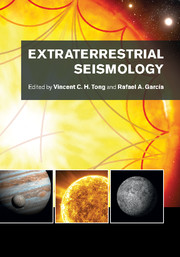Book contents
- Frontmatter
- Contents
- List of contributors
- Preface
- Acknowledgements
- List of abbreviations
- Planetary seismology: High risk, high return
- A bright outlook for helio- and asteroseismology
- Part I Observation and space missions
- Part II Data and physical parameters
- Part III Modeling approaches
- Part IV Discoveries of physical structures and processes
- 11 Asteroseismology of red giant stars
- 12 A helioseismic view of the Sun's internal structure and dynamics
- 13 Recent discoveries of structures and physical processes in local helioseismology
- 14 Seismology of giant planets
- 15 Seismicity and interior structure of the Moon
- Part V Interdisciplinary research involving planetary and astrophysical sciences
- Part VI Interdisciplinary research involving terrestrial seismology
- References
- Index
13 - Recent discoveries of structures and physical processes in local helioseismology
from Part IV - Discoveries of physical structures and processes
Published online by Cambridge University Press: 05 July 2015
- Frontmatter
- Contents
- List of contributors
- Preface
- Acknowledgements
- List of abbreviations
- Planetary seismology: High risk, high return
- A bright outlook for helio- and asteroseismology
- Part I Observation and space missions
- Part II Data and physical parameters
- Part III Modeling approaches
- Part IV Discoveries of physical structures and processes
- 11 Asteroseismology of red giant stars
- 12 A helioseismic view of the Sun's internal structure and dynamics
- 13 Recent discoveries of structures and physical processes in local helioseismology
- 14 Seismology of giant planets
- 15 Seismicity and interior structure of the Moon
- Part V Interdisciplinary research involving planetary and astrophysical sciences
- Part VI Interdisciplinary research involving terrestrial seismology
- References
- Index
Summary
Introduction
One of the greatest remaining mysteries surrounding the Sun is the mechanism of its magnetic activity cycle. Most prominently, the number of sunspots repeatedly increases and decreases with an approximate period of 11 years. This must be a result of interactions between various flows and magnetic fields in the Sun, broadly called a dynamo mechanism. Pinning down the mechanism of the solar dynamo would require concerted efforts between theory and observation. Therefore it is of paramount importance, as an observational approach in our attempt to understand the solar dynamo, that we measure these internal flows and, if possible, magnetic fields in the Sun.
Among the various flows, of particular interests are the two components of large-scale flows, i.e., differential rotation and meridional circulation. Convective flows, in particular supergranules, the flows associated with super granulation, are also of great interest. The origin of super granules is still debated, but they are normally considered as convective cells, typically with a spatial scale of 3 × 104 km and a lifetime (∼ the turnover time) of about a day.
The Sun rotates with a period of about a month, but the equator rotates faster than the poles – the Sun rotates differentially. The solar differential rotation is directly responsible for the so-called ω effect, in which the toroidal component (the ϕ component in spherical coordinates) of the magnetic field is produced by shearing the poloidal component (the component in the r–θ plane). It also provides the Coriolis force, which is important in the less understood α effect, in which the poloidal component is produced from twisting the toroidal magnetic field. Meridional flows transport magnetic flux latitudinally by advection. Supergranulation is believed to be important in diffusive transport of the solar magnetic fields. For general reviews of large-scale flows in the Sun and the solar dynamo, readers are referred to Miesch (2005) and Charbonneau (2010), respectively.
- Type
- Chapter
- Information
- Extraterrestrial Seismology , pp. 180 - 188Publisher: Cambridge University PressPrint publication year: 2015

